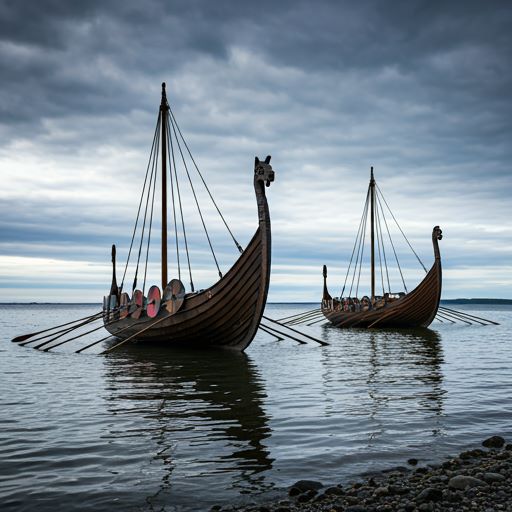

The Maritime Silk Road was a network of sea routes that connected East Asia, Southeast Asia, South Asia, the Middle East, Africa, and Europe. Chinese junks, massive sailing vessels, were at the heart of this maritime trade. These ships carried precious cargo like silk, porcelain, spices, and other valuable goods across vast oceans. The Silk Road fostered cultural exchange, the spread of ideas, and economic prosperity, leaving a lasting impact on global history.

Sailors often find penguins captivating, as they are global emblems of endurance. Mostly inhabiting the southern hemisphere, these birds share sailors' dedication to family. African penguins are particularly sociable, residing in colonies where they partake in communal activities similar to sailors forming bonds at sea. They exhibit meticulous care by grooming, preening, and feeding one another, mirroring the solidarity sailors maintain for protection against predators, underscoring the significance of unity.

Comoros, an island nation located in the Indian Ocean between Mozambique and Madagascar, is known as the "Perfume Isles" due to its fragrant plant life, especially the ylang-ylang flower. In fact, it is the world's largest producer of ylang-ylang, supplying around 80% of the world's ylang-ylang flowers used in the famous perfume Chanel No 5. The first confirmed human inhabitants of Comoros are believed to be of Malayo-Polynesian descent, arriving by the 5th or 6th century

Moroni, the capital of Comoros, is a city steeped in history and natural beauty. It is known for its numerous mosques, the most notable being the Badjanani Mosque, dating back to 1427. The city is nestled in the shadow of Mount Karthala, an active volcano, offering breathtaking views. Despite its small size, Moroni exudes a relaxed atmosphere, a legacy of its French colonial past. The city serves as the main gateway to the Comoros Islands, welcoming visitors with its blend of cultures and stunning coastal scenery.

Steam ships, once the epitome of maritime speed and efficiency, were powered by coal and often featured distinctive paddle wheels. These vessels revolutionized transportation across oceans, playing a pivotal role in the development of the cruise industry. Known for their luxurious accommodations and fine dining, steam ships were seen as symbols of technological progress and innovation during their time. However, the advent of diesel-powered ships in the 20th century led to their gradual decline. Many historic steam ships have been preserved as museums or tourist attractions, serving as a testament to their enduring legacy and a reminder of a bygone era.

Some of the earliest sailing vessels were simple reed boats or hollowed-out logs, used for fishing and transportation. Ancient civilizations like the Egyptians and Vikings developed more advanced ships, such as galleys and longships, for trade, warfare, and exploration. Egyptian galleys were powered by both sails and oars, while Viking longships were known for their speed and maneuverability.

The Chinese junk ship and the Portuguese caravel were significant advancements in sailing technology. These vessels were used for long-distance trade and exploration, shaping the course of history. Chinese junk ships were large, multi-masted vessels with distinctive sails shaped like batwings, while caravels were smaller and more maneuverable, with triangular lateen sails. Pirate ships were also adapted from merchant vessels for plundering and attacking other ships. Most early sailing ships were constructed of wood, with sails made from various materials like linen, cotton, and hemp.

Viking longships were versatile vessels known for their speed, maneuverability, and iconic dragon heads. These ships, constructed primarily of wood, were propelled by both oars and sails. Vikings used them for raids, trade, and exploration, reaching distant lands like Iceland, Greenland, and North America. A few well-preserved examples of these historic ships have been discovered and are now on display in museums.

Egyptian galleys were powerful warships and merchant vessels that played a crucial role in ancient Egyptian civilization. These vessels were propelled by both oars and sails, allowing them to navigate rivers, lakes, and the Mediterranean Sea.
They were often decorated with intricate carvings and paintings, depicting gods, goddesses, and scenes from Egyptian mythology. Galleys were used for trade, warfare, and ceremonial purposes, and their design and construction were a testament to the Egyptians' advanced shipbuilding skills.

Kutch, a region in western India, has a long and rich maritime history. Kutch sailors were renowned for their skill in navigating traditional dhows, sailing vessels that were well-suited for the Indian Ocean's conditions. They established trade routes connecting India to other parts of the world, traded goods such as textiles, spices, and precious stones, and fought pirates. Many Kutch sailors also served in the Indian Navy. The seafaring tradition in Kutch has been passed down through generations, influencing the unique culture of Kutch sailors. Even today, Kutch sailors continue to embark on adventurous voyages, exploring the Indian Ocean and participating in traditional sailing races.